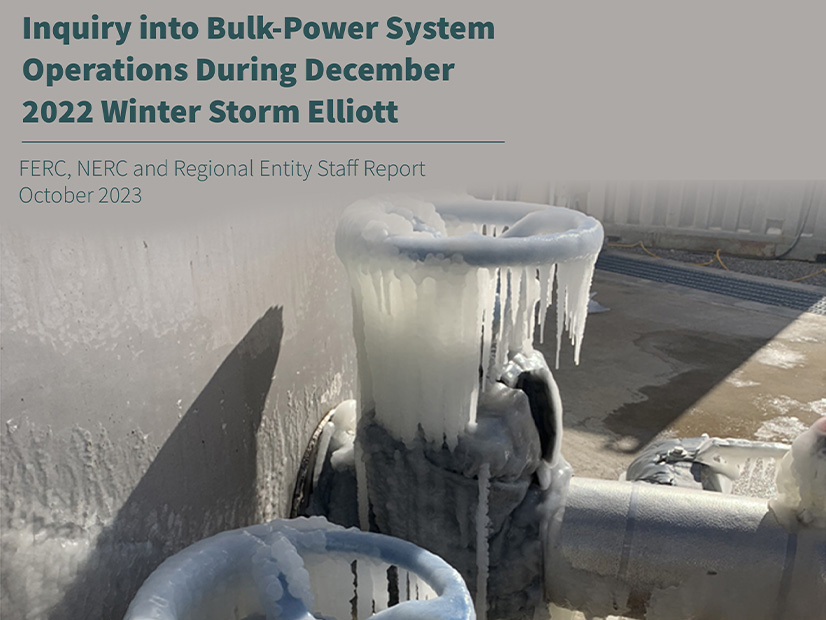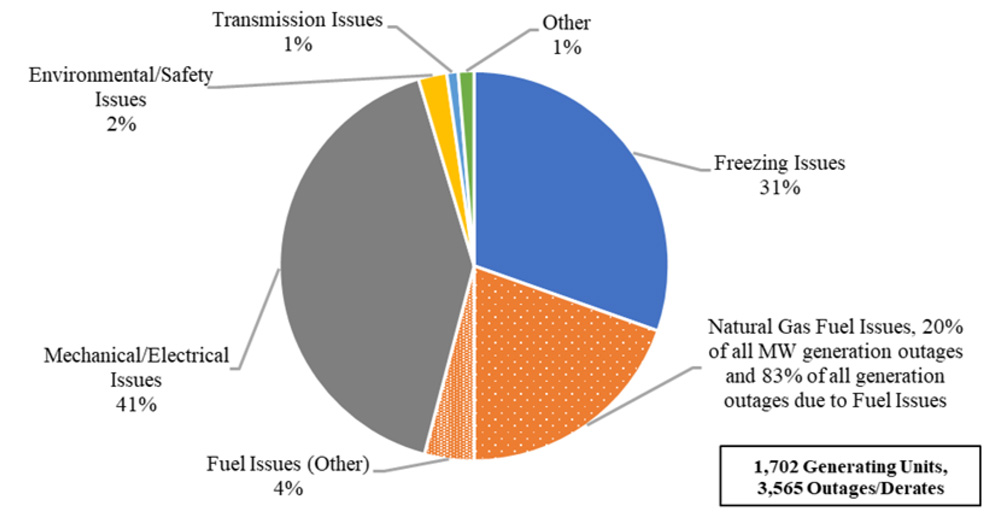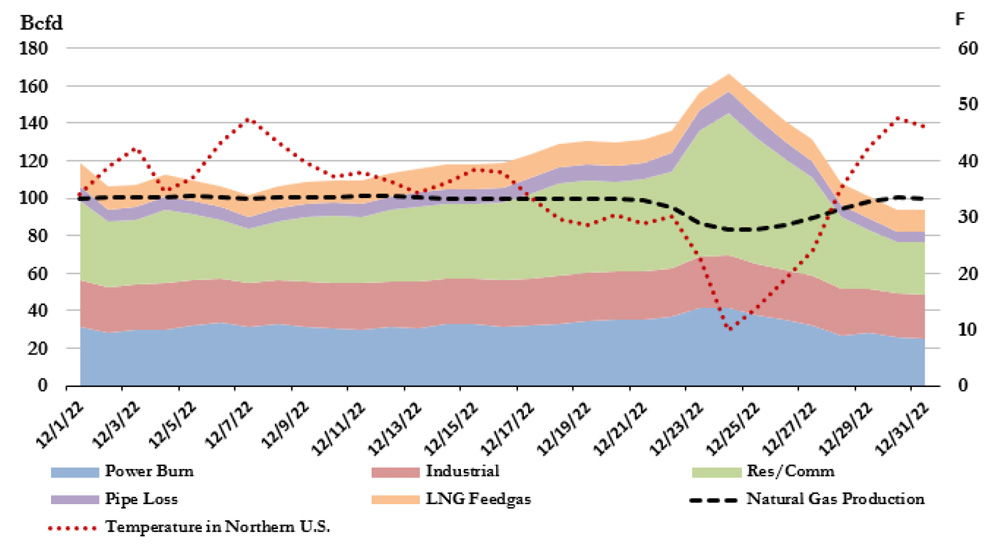FERC and NERC’s final report on the December 2022 winter storm laid out “an unacceptably familiar pattern” of extreme cold temperatures leading to widespread generation outages across the Eastern Interconnection.
The report issued Nov. 7 noted that North America’s electric grid and natural gas infrastructure “continue to be severely challenged during extreme cold weather events” despite repeated warnings after multiple recent similar storms.
The December 2022 event — known as Winter Storm Elliott — began with a bomb cyclone and extratropical cyclone, both indicating a storm associated with a rapid drop in pressure, that moved from the upper Plains states eastward and reached the Eastern U.S. by Dec. 23. An “unprecedented” amount of generation failed during the event, reaching more than 90 GW in coincident unplanned outages.
Most of the entities that shed load were in the Southeast U.S., the report said, including the Tennessee Valley Authority, Louisville Gas and Electric/Kentucky Utilities, Duke Energy Progress and Duke Energy Carolinas, and Santee Cooper. Other entities did not shed load but had to issue energy emergency alerts, such as PJM, Southern Co., MISO, SPP and ISO-NE. All affected entities “experienced significant unplanned generating unit outages, derates or failures to start within their footprints.”
The report noted that, similar to previous cold weather events, entities had warning of the coming frigid weather “well in advance” and many had “issued cold weather preparation notices to their generation and transmission owners and operators.” Temperatures were not as low as in the winter storms of February 2021. However, wind speeds were higher in many places, leading temperatures to drop faster than in 2021. For example, TVA “reported a drop of 46 degrees [Fahrenheit] in five hours.”
Natural gas declined significantly during the event, due in part to freezing of gas wellheads and other equipment which could not be repaired quickly due to poor road conditions. The report called the gas production decline the greatest since the 2021 storm, with production at the Marcellus Shale and Utica Shale formations falling by up to 54%. Fuel supply issues at natural gas facilities accounted for 20% of the 3,565 generating unit outages and derates during the event (by MW); fuel issues for other resources came to just 4% of the total.
Other leading causes of outages and derates included mechanical and electrical issues (41% by MW) and freezing issues (31%). The report noted that FERC and NERC “had provided multiple prior recommendations and follow-up activities regarding steps for winter preparedness,” and that most affected generator owners had plans of their own in place for extreme weather. Nevertheless, more than 75% of the generating units that failed due to freezing issues did so in temperatures above their documented minimum operating temperatures.
Recommendations Include Gas Reliability Actions
The report provided 11 recommendations for preventing similar events in the future, which the authors acknowledged were “built on previous analyses and findings” from cold weather events over the past decade.
The first recommendation is to finish implementing the revisions to NERC’s reliability standards suggested in the FERC-NERC joint report on the winter storms of February 2021. The report’s authors noted that “while some changes were implemented in response to previous … events, generators and natural gas supply and infrastructure remain vulnerable to extreme cold weather.” (See FERC Approves More Extreme Weather Rules.)
Additional recommendations for generator reliability include implementing “robust monitoring” by NERC and the regional entities to ensure compliance with reliability standards and to determine if gaps exist. The report also called for NERC to initiate a technical review of the causes of unplanned generation outages related to mechanical and electrical issues during the event, along with a study by NERC, FERC and the REs to examine the “overall availability and readiness of blackstart units … during cold weather conditions” across the entire U.S.
But perhaps the biggest recommendation of the report was the call for Congress and state legislatures to pass legislation establishing “reliability rules for natural gas infrastructure necessary to support the grid” and local gas distribution. Elaborating on this point, the authors outlined potential structures similar to the ERO, with regional natural gas communications coordinators fulfilling a role similar to the electric grid’s reliability coordinators.
In a joint statement, NERC CEO Jim Robb and FERC Chair Willie Phillips endorsed this idea, repeating calls for a gas reliability organization that they made when the report was previewed at the commission’s September open meeting. Their support for such an organization echoes a similar call issued by the chairs of NAESB’s Gas-Electric Harmonization Forum earlier this year. (See NAESB Forum Chairs Push for Gas Reliability Organization.)
“As the report lays out, we narrowly dodged a crisis last year. Had the weather not warmed up on Christmas Day, it is highly likely that natural gas service would have been disrupted to New York City,” Robb said. “The unplanned loss of generation due to freezing and fuel issues was unprecedented, reflecting the extraordinary interconnectedness of the gas and electric systems and their combined vulnerability to extreme weather.”
In a statement, Todd Snitchler, CEO of the Electric Power Supply Association, said EPSA takes the report’s findings seriously and is “committed to improving power system performance in all weather and demand scenarios.” He added that “power generation outages involving all types of resources … must be addressed and corrected.”
“The report reveals that no market model, region of the country or fuel type is immune to the challenges experienced during Elliott. A well-designed competitive power market, however, is the best foundation to serve power needs reliably and efficiently,” Snitchler said. “Areas of the country served by competitive power markets fared comparatively well during the storm when it came to resource adequacy … [while] regions served by public power and vertically integrated entities were subject to more than 5,400 MW of load shed at various times during the event.”
NERC and FERC plan to hold a webinar for industry on the report’s recommendations “at the end of November,” the joint statement said. The date for the webinar has not been set.





